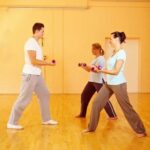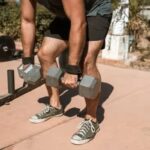How to fit exercise into homeschool is a common concern for many parents who have taken on the responsibility of educating their children at home. It’s important to understand the significance of incorporating physical activity into homeschool routines, as it has numerous benefits for both children and parents alike.
Regular exercise during homeschooling not only promotes physical health but also has a positive impact on mental well-being. Research has shown that physical activity can enhance cognitive function, improve concentration, and reduce stress and anxiety levels in both children and adults. With the added challenge of balancing teaching responsibilities with household tasks, finding time for exercise may seem daunting, but with some effective time management strategies and creative planning, it is certainly possible.
In this article, we will explore the various benefits of exercising during homeschooling, time management tips for fitting workouts into busy schedules, ideas for integrating physical education into lesson plans, utilizing outdoor spaces for fitness activities, indoor exercise options, creating a family fitness plan, and motivating reluctant learners to embrace physical activity. Prioritizing exercise in the homeschooling environment is crucial for the overall well-being of the entire family.
Benefits of Exercising During Homeschool
Exercising during homeschooling offers a myriad of benefits for both children and parents. Not only does it contribute to physical health, but it also has positive effects on mental well-being. Incorporating regular exercise into the homeschool routine can help children and parents maintain a healthy lifestyle while dealing with the demands of home-based learning.
Engaging in physical activity has been proven to boost mood and reduce stress and anxiety levels. For children, regular exercise can lead to improved concentration and cognitive function, which are essential for academic success. Additionally, physical activities can provide an outlet for pent-up energy, leading to better behavior and increased focus during study sessions. Likewise, parents can benefit from the stress-relieving properties of exercise, allowing them to approach homeschooling with a clear mind and a more positive attitude.
Furthermore, introducing exercise during homeschool hours creates an opportunity for bonding between children and parents. It allows for shared experiences that strengthen family relationships while promoting a healthy lifestyle. By demonstrating the importance of fitness through consistent practice, parents can instill lifelong habits that will benefit their children in the long run.
Adding physical activity to the homeschooling schedule may seem challenging at first, but it is essential for overall well-being. Implementing strategies that prioritize exercise within homeschooling not only fosters healthy habits but also contributes significantly to the physical and mental health of both children and parents.
| Benefits of Exercising During Homeschool | Mental and Physical Health Benefits |
|---|---|
| Improved concentration and cognitive function | Shared experiences that strengthen family relationships |
| Reduced stress and anxiety levels | Demonstrating the importance of fitness through consistent practice |
| Better behavior and increased focus during study sessions | Fosters healthy habits for both children and parents |
Time Management Tips
One of the biggest challenges for homeschooling parents is finding time to incorporate exercise into their daily routine. With the demands of teaching and managing a household, it can be difficult to prioritize physical activity. However, making time for exercise is crucial for both children and parents. Here are some strategies for finding time to fit exercise into your homeschooling schedule:
Time Management Tips:
- Create a schedule: Plan out your homeschooling activities and designate specific times for exercise. By creating a schedule, you can ensure that physical activity becomes a non-negotiable part of your daily routine.
- Combine exercise with learning: Look for ways to integrate physical activity into your lesson plans. For example, you can have kids do jumping jacks while reciting multiplication tables or take a nature walk to learn about plants and wildlife.
- Involve the entire family: Incorporate family fitness time into your schedule. You can engage in group activities such as yoga sessions, dance parties, or outdoor sports that everyone can participate in.
By implementing these time management strategies, homeschooling parents can effectively carve out time for exercise amidst their responsibilities.
Overall, finding time to fit exercise into homeschooling may seem challenging at first but with proper planning and creativity, it is entirely possible. Prioritizing physical activity not only benefits your children’s health but also offers you an opportunity to destress and stay active alongside them. Ultimately, by making exercise a priority in your daily routine, you are setting a positive example for your children and instilling healthy habits that will last a lifetime.
Incorporating Physical Education Into the Curriculum
Physical education is an important aspect of a well-rounded homeschooling curriculum, yet finding the time and resources to incorporate exercise into daily lesson plans can be challenging. However, with some creativity and strategic planning, integrating physical activity into homeschool routines is not only achievable but also highly beneficial for both children and parents.
Planning Active Lessons
One effective way to ensure that exercise becomes a regular part of homeschooling is by incorporating active lessons into the curriculum. This can involve integrating movement-based activities into various subjects such as math, science, or even history.
For example, instead of sitting at a desk to solve math problems, children can engage in a scavenger hunt around the house to find items that represent different numbers or concepts. This not only gets them moving but also makes learning more interactive and memorable.
Utilizing Online Resources
In today’s digital age, there are numerous online resources and programs specifically designed to provide physical education for homeschoolers. Websites and apps offer videos for yoga, dance classes, workout routines, and other forms of exercise suitable for children of all ages. Including these resources in the homeschool schedule ensures that kids get their daily dose of physical activity while also allowing parents to participate if they wish.
Setting Up Obstacle Courses and Fitness Challenges
Another fun way to incorporate exercise into daily lesson plans is by creating obstacle courses or fitness challenges tailored to specific learning objectives. For example, setting up a math-themed obstacle course where kids have to solve equations at different stations before moving on to the next challenge can blend physical activity with academic content seamlessly. This approach not only promotes physical fitness but also cultivates problem-solving skills and critical thinking.
By creatively integrating exercise into daily lesson plans, homeschooling families can ensure that physical education becomes an integral part of their routine. From active lessons and online resources to fun fitness challenges, there are countless ways to make exercise an enjoyable and educational experience for both children and parents.
Utilizing Outdoor Spaces
When it comes to fitting exercise into homeschool routines, utilizing outdoor spaces can be a game changer. Not only does outdoor physical activity provide an opportunity for children to expend energy and improve their well-being, but it also allows parents to incorporate exercise into their own schedules. Outdoor workouts offer numerous benefits, from exposure to natural sunlight and fresh air to the expansive space available for various activities.
Benefits of Outdoor Exercise
Outdoor physical activity offers unique advantages that are difficult to replicate indoors. Whether it’s playing tag in the backyard, going for a family hike, or simply enjoying a game of soccer at the park, outdoor exercise allows children and parents alike to experience the benefits of nature while engaging in physical activity.
Studies have shown that spending time outdoors can lead to improved mood, reduced stress levels, and enhanced cognitive function, making it an ideal environment for incorporating exercise into homeschool routines.
Fun Outdoor Activities
There are countless ways to make the most of outdoor spaces for physical activity and exercise. From setting up obstacle courses in the backyard to organizing scavenger hunts in local parks, there are plenty of creative and enjoyable activities that can keep both children and parents active and engaged.
Additionally, outdoor spaces provide ample room for sports such as basketball, soccer, and tennis, offering opportunities for skill development while promoting an active lifestyle. By incorporating these activities into homeschool schedules, families can prioritize physical health and well-being while also enjoying quality time together outdoors.
Indoor Exercise Options
When it comes to homeschooling, finding time and space for physical exercise can sometimes be challenging. However, there are plenty of indoor exercise options that can be easily incorporated into the homeschool routine. One great way to fit exercise into homeschool is by implementing fun and engaging workouts and activities that can be done at home. From dance parties to yoga sessions, there are numerous ways to keep both children and parents active without having to leave the house.
One effective indoor exercise option is to set up a designated workout area in the home. This could be a small corner of a room or even just a clear space in the living room. By designating a specific area for physical activity, it becomes easier to integrate regular exercise into the daily homeschool schedule. Additionally, having an established workout space can make it more convenient for everyone to participate in indoor workouts and activities.
Another way to fit exercise into homeschool is by incorporating interactive video workouts or fitness programs into the curriculum. Many online platforms offer kid-friendly workouts that are both educational and fun. These programs not only provide opportunities for physical activity but also teach children about the importance of health and fitness. By making use of these resources, parents can easily add structured exercise routines into their homeschool lesson plans.
In addition, utilizing everyday household items for exercise can be an effective way to stay active indoors. Simple activities like playing “the floor is lava” or creating obstacle courses using furniture and other items can provide both entertainment and physical movement for children.
These types of games not only help kids stay active but also encourage creativity and problem-solving skills. Overall, integrating indoor workouts and activities into the homeschool routine not only keeps everyone physically active but also fosters a healthy lifestyle for the whole family.
Creating a Family Fitness Plan
When homeschooling, it’s important to prioritize physical activity and exercise for the entire family. Creating a family fitness plan that complements the homeschool schedule not only promotes physical health but also strengthens family bonds and provides a break from academic responsibilities. Here are some strategies and ideas for engaging the entire family in a fitness routine:
- Set specific times for family workouts: Schedule regular times for family exercise, such as morning or afternoon workouts, to ensure that everyone participates.
- Choose activities that appeal to everyone: Consider each family member’s interests and preferences when selecting exercises or activities. This could include playing sports, going on nature walks, doing yoga, or even dancing together.
- Track progress together: Create a chart or system for tracking the family’s physical activity and celebrate milestones together, such as reaching a certain number of steps walked or minutes of exercise completed each week.
In addition to scheduled workouts, incorporating physical activity into daily routines can also contribute to overall fitness. Encourage children to take active breaks between lessons, such as jumping jacks, stretching exercises, or quick walks around the house. For parents, finding ways to integrate movement into household chores can also be beneficial.
Ultimately, the key is to make exercise enjoyable and manageable for everyone in the household. By involving the entire family in a fitness plan that aligns with the homeschool schedule, not only will physical health improve but so will mental well-being and family dynamics. Making time for exercise will enhance overall productivity and create lifelong healthy habits for both children and parents alike.
Whether it’s through outdoor activities, indoor workouts, or structured fitness plans, finding creative ways to engage the whole family in physical activity is essential for promoting a healthy lifestyle while homeschooling. By prioritizing exercise within the homeschool routine, families can benefit from improved physical health and enhanced emotional well-being.
Motivating Reluctant Learners
Being a homeschool parent comes with unique challenges, and one of them may be motivating reluctant learners to engage in physical activity. However, it is essential to prioritize exercise for the overall well-being of your children. Here are some strategies for encouraging children who may be resistant to physical activity.
First and foremost, it’s important to make exercise enjoyable for your children. Incorporating activities that they love, such as playing their favorite sports, dancing, or even going for nature walks, can make a huge difference. You can also involve them in the decision-making process by letting them choose the type of physical activities they want to participate in.
Another effective strategy is setting a positive example as a parent. Children often emulate the behavior of their parents, so if they see you prioritizing exercise and enjoying physical activities, they are more likely to follow suit. Consider involving the entire family in fitness routines so that exercising becomes a shared experience.
Moreover, offering incentives and rewards can motivate reluctant learners to engage in physical activity. For example, you could create a reward system where they earn points for every workout session completed and then trade those points for something they desire. Positive reinforcement can go a long way in encouraging children to participate in exercise willingly.
| Strategies | Benefits |
|---|---|
| Incorporate fun activities | Makes exercise enjoyable for children |
| Set a positive example | Children are likely to mimic parent’s behavior |
| Offer incentives and rewards | Positive reinforcement encourages participation |
Conclusion
In conclusion, finding ways to fit exercise into homeschooling routines is essential for the overall well-being of both children and parents. The benefits of regular physical activity, such as improved mental health, increased focus, and boosted energy levels, are all crucial for a successful homeschooling experience. By prioritizing exercise and incorporating it into daily schedules, families can promote a healthy lifestyle while also enhancing their academic pursuits.
When it comes to managing time for exercise within the homeschooling day, it’s important to get creative and think outside the box. From utilizing outdoor spaces for physical activities to implementing indoor workout routines, there are numerous options available. By integrating physical education into the curriculum and involving the whole family in a fitness plan, homeschooling can become an opportunity for holistic growth and development.
By employing various strategies to motivate reluctant learners and make exercise a fun and enjoyable part of the homeschool routine, parents can instill lifelong habits of health and wellness in their children. Ultimately, prioritizing exercise in homeschooling not only contributes to physical fitness but also nurtures positive mental health. It’s about creating a balanced approach that fosters the overall well-being of the entire family.
Frequently Asked Questions
How Do You Balance Homeschooling and Working From Home?
Balancing homeschooling and working from home requires careful planning and flexibility. Setting a schedule that accommodates both work and school hours is essential. Communication with your employer about your situation can also help in managing expectations.
How Do Homeschoolers Do PE?
Homeschoolers often get creative when it comes to physical education. They may participate in community sports programs, take dance or martial arts classes, or simply engage in outdoor activities like biking, hiking, or playing sports with family and friends.
How Do You Socialize While Homeschooling?
Socializing while homeschooling involves seeking out opportunities for interaction with peers. This can include joining homeschool co-ops, sports teams, or clubs. Additionally, attending community events, volunteering, and scheduling playdates can help homeschoolers develop friendships and social skills.

Passionate about providing useful information to anyone with an interest in the field of Personal Training, I strive to pass on to our readers quality information and to answer any questions about Personal Trainers, the work they do and how to become one.





